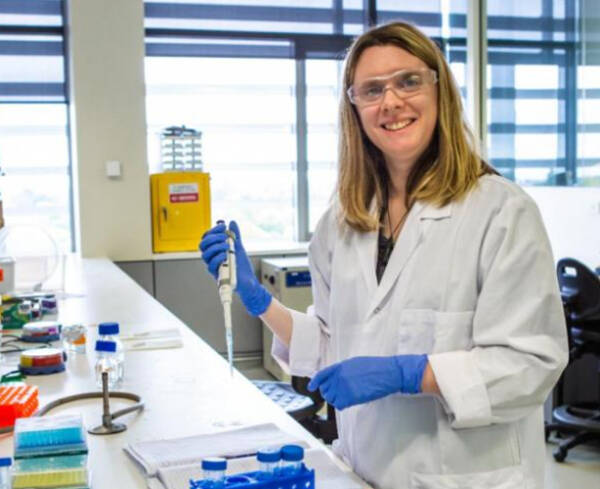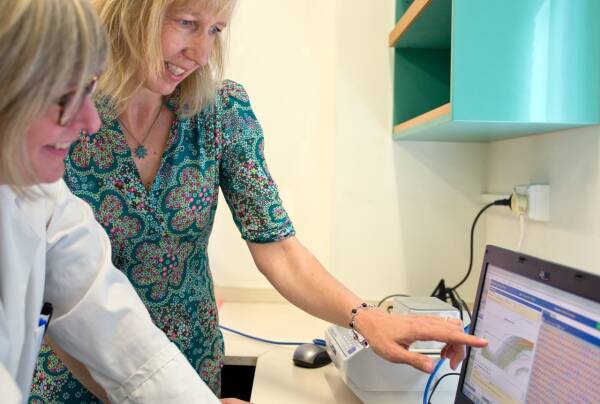Newly-funded, world-leading research will push forward this pioneering idea, which may lead to earlier diagnosis and treatment for Kiwis.
A multidisciplinary team of researchers across New Zealand will collaborate over the next two years in an effort to confirm whether the concept could work. The Neurological Foundation has funded the $307,444 project, which is being led by a team from the Universities of Canterbury and Otago working alongside researchers from the University of Auckland.
It taps into two longitudinal studies currently underway in New Zealand that focus on neurodegenerative diseases. Participants will be asked to gently shed some tears. The tears will then be tested for the tell-tale sign of Parkinson’s disease.

Professor John Dalrymple-Alford
According to the lead investigator, Professor John Dalrymple-Alford, this could aid the clinical diagnosis for patients. If so, this would also be useful to determine if someone is at risk of Parkinson’s, as well as help doctors monitor and manage earlier treatment for the disease itself.
“Currently, a lumbar puncture is the best way of testing this – but this procedure is invasive, expensive, and currently only used in a research context,” says Professor Dalrymple-Alford. “Blood and other tissues are also being evaluated, but the prospect of using people’s tears has many benefits.
“Collecting tears is a low-impact procedure. It uses a sterile strip of “filter paper” to collect tear fluid from the lower surface of the eye. This would be ideal for an initial clinical test of the key molecular sign of Parkinson’s. So, this long-standing medical technique might now be part of a regular diagnostic examination for Parkinson’s.”
Frequent testing using tears is simpler and better tolerated by the patient than repeat blood sampling, says John. “Tears also provide an easy source of a host of biological material so other factors can be tested at the same time.”
There’s been growing interest in looking at the eye and its tears to help understand medical conditions. This research is the first to adapt the latest biochemical techniques to use tears to uncover some of the hidden secrets of Parkinson’s.
The researchers say they’ll compare the results from people with Parkinson’s with those from people who show evidence for Alzheimer’s disease, as well as tears from age-matched controls. They’ll look for changes that are both specific to, and overlap, the two neurodegenerative conditions.

Professor Tim Anderson
Professor Tim Anderson from the New Zealand Brain Research Institute and University of Otago who is also a neurologist, says, “Other body tissues such as skin and salivary glands have also shown evidence of increased amounts of the alpha-synuclein protein but this requires a biopsy – another invasive procedure. A simple process of tear collection and protein analysis could lead to a convenient and accessible way to help clinicians to diagnose and treat Parkinson’s at its earliest beginnings.”
The Neurological Foundation’s Head of Research, Dr Sarah Schonberger, says the collaborative nature of this project was one of its strengths when being considered for funding. “The combined research and clinical expertise across the team makes it more likely to be successful,” she says. “It’s exciting to think that it could lead to a simple, low-cost diagnostic tool that would be of great benefit to patients and their doctors.”
Ms Diane Guevremont (left) & Associate Professor Joanna Williams

Dr Vanessa Morris
The team working on this project
Lead investigators: Professor John Dalrymple-Alford & Dr Vanessa Morris (New Zealand Brain Research Institute and University of Canterbury) and Associate Professor Joanna Williams (University of Otago). Other key investigators: Professor Tim Anderson, Associate Professor Tracy Melzer, Dr Toni Pitcher, Dr Daniel Myall & Dr Campbell Le Heron (New Zealand Brain Research Institute and University of Otago); Diane Guevremont, Dr Nick Cutfield and Professor Chris Frampton (University of Otago); and, Professor Lynette Tippett & Dr Erin Cawston (University of Auckland). Tim Anderson and Campbell Le Heron are also members of Te Whatu Ora Waitaha Canterbury, and Nick Cutfield is a member of Te Whatu Ora Southern.
The Neurological Foundation – the only dedicated funder of neurological research in New Zealand – has just announced more than $3 million in funding – the most it has ever invested in one grants round.
Other projects funded in the Foundation’s latest round include:
Associate Professor Miriam Scadeng, University of Auckland
$295,267
Neuroinflammation
Inflammation in the brain is common in injury and disease, and detecting it is important for early intervention. A team from Matai Medical Research Institute, the University of California, San Diego, and the University of Auckland, have developed a new, highly-sensitive MRI technique that could be used in the clinic to detect early inflammation in the brain. The aim of this project is to validate their new technique so that it can be translated to the clinic.
Dr Erin Cawston, University of Auckland
$279,474
Dementia
This study involves 250 participants from the Dementia Prevention Research Clinics and aims to determine if Alzheimer’s disease can be detected using a blood test. Currently, Alzheimer’s disease can only be definitively diagnosed by looking at the brain after death, or through expensive and invasive testing. A blood test would be cost-effective, allowing equitable access nationwide to testing for accurate diagnosis of people with cognitive symptoms.
Dr Dean Singleton, University of Auckland
$271,922
Brain cancer
A team at the Auckland Cancer Society Research Centre are investigating brain cancers where a mutation causes the affected brain cells to become cancerous. They have discovered how these cancer cells survive in the brain. This project aims to test existing drugs that are already in routine clinical use, as well as potential new treatments, that can block the ability of the cancer cells to survive in the brain and lead to new treatments for brain cancer.
Professor Valery Feigin, Auckland University of Technology
$179,994
Stroke
The Stroke Riskometer™ is a free app that can assess an individual’s risk of stroke, heart attack, dementia, and diabetes. This project will use data from more than 500,000 New Zealanders to improve the accuracy of the app for New Zealand’s unique population. It will contribute significantly to current knowledge in stroke prevention and interventions for reducing stroke.
Associate Professor Louise Bicknell, University of Otago Dunedin
$15,000
Neurological disorders
This project focuses on a family of proteins whose genes are involved in multiple neurological disorders. Understanding how these proteins work together in the brain will improve understanding of how they influence disease. This small project grant will provide the evidence needed to develop a new area of study into developmental and neurodegenerative disorders.
Dr Maize Cao, University of Auckland
$15,000
Motor neuron disease
Amyotrophic lateral sclerosis (ALS) is a tragic movement disorder, in which motor neurons, the messengers between brain and muscle, die off. Currently, there are multiple theories on how the motor neurons die. This project will investigate what these theories have in common, and identify common features of ALS that could lead to new therapies.
Professor Louise Parr-Brownlie, University of Otago Dunedin
$15,000
Parkinson’s disease
The standard drug treatment for Parkinson’s disease is levodopa, but 90% of patients develop side-effects of involuntary, uncontrollable movements (dyskinesia) from long-term use. This study will investigate changes in the brain in dyskinesia to improve understanding of why it occurs, so that new treatments can be developed to reduce or prevent it.
Dr Jui-Lin (Mickey) Fan, University of Auckland
$14,940
Stroke
Successful stroke treatment involves restoring blood flow to affected brain regions within hours, which is a significant challenge for New Zealanders living in isolated regions. This study will trial a new treatment to control brain blood flow in patients who are at high risk of stroke. Insights gained from this research could lead to a new stroke treatment that can be delivered inside the ambulance.
Dr Matthew Munro, Gillies McIndoe Research Institute
$13,480
Brain cancer
Meningioma is the most common type of brain tumour, yet there are currently no standard drugs to treat it. This project will test other cancer drugs on meningioma cells donated by patients, to see if any of the common cancer drugs could be used to effectively treatment meningioma.
2 x Senior Research Fellowships
Dr Rachael Taylor, University of Auckland
$296,736
Balance disorders
The cerebellum is the part of the brain essential for balance and coordination, including eye movements. It is also connected to the balance organs of the inner ear. This research aims to understand how genetic changes affect the way the cerebellum and balance organs work together to influence eye movements. This information could aid diagnosis of cerebellar disorders and provide a basis for developing and monitoring treatments.
Dr Sarah Borrie, University of Auckland
$282,723
Alzheimer’s disease
Immune cells called microglia are the brain’s cleaning crew. This cleaning-up process seems to go wrong in Alzheimer’s disease, leading to a build-up of amyloid in the brain. This project will study what goes wrong with the waste clearance system inside microglia cells during Alzheimer’s Disease, paving the way for future drug discovery research targeting these cells.
2 x First Fellowships
Dr Susan Li, University of Auckland
$248,576
Brain cancer
The current standard of care for brain tumours includes radiation therapy, but it can have unwanted effects on healthy brain tissue. Susan’s project at the Centre for Brain Research is looking for ways to protect healthy brain tissue while ensuring radiation therapy is still effective at killing cancer cells.
Dr Gretel Major, University of Canterbury
$216,923
Duchenne muscular dystrophy
Current therapies for Duchenne muscular dystrophy (DMD) have effects on the nervous system that are not fully understood. Gretel’s project in the Neurology of Myopathies Lab at the University of Canterbury will investigate how DMD treatments are impacting on the nervous system.
VJ Chapman Fellowship
Dr Joseph Donnelly, Te Whatu Ora Te Toka Tumai Auckland Hospital
$208,075
Parkinson’s disease
In the western Pacific a form of Parkinson’s disease (known as PINK1 Parkinson’s disease) has been recently discovered that runs in families and affects individuals as young as teenagers. This project will answer fundamental questions about this early onset form of Parkinson’s disease: What does this condition look like? How does it respond to treatment? What can this condition tell us about Parkinson’s disease in the elderly?
Senior Clinical Research Fellowship
Dr Benson Chen, University of Auckland
$166,939
Autoimmune disorders
Optic neuritis is a condition where the immune system attacks the optic nerve connecting the eyeball and the brain, resulting in reduced vision. Using advanced eye imaging, this study aims to develop tools to diagnose and monitor optic neuritis that can be introduced into the clinic, to improve outcomes for patients with autoimmune neurological disorders.
Philip Wrightson Fellowship
Dr Sam Hall-McMaster, Harvard University
$135,698
Memory
This project will use the latest advances in machine learning and human brain imaging to understand how the brain reorganises memories and learning over time. This will lead to a better understanding of the memory systems impaired in neurological disorders.
The Neurological Foundation also awarded $65,413 in travel grants. For more details head to https://neurological.org.nz/research/funded-projects
About Parkinson’s disease:
Around 13,000 Kiwis have Parkinson’s disease, and that figure is expected to rise significantly in coming years. The most common symptoms are slowness of movements, stiffness, and tremor. It also impacts on people’s thought patterns and emotions and can affect their ability to communicate.
Parkinson’s disease has traditionally been diagnosed by clinicians and until recently there has been no laboratory confirmatory test. A specific protein abnormality, accumulation of alpha-synuclein, is the hallmark of Parkinson’s. Previously, this was detectable only through brain autopsy. Recent advances uncovered its presence in the fluid bathing brain and spinal cord (cerebrospinal fluid), but this requires a spinal puncture. Other body tissues such as skin and salivary glands have also shown evidence of increased amounts of the alpha-synuclein protein but this requires a biopsy, another invasive procedure. A simple process of tear collection and protein analysis could lead to a convenient and accessible way to assist clinicians to diagnose and treat Parkinson’s at its earliest beginnings.







